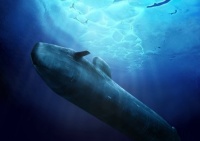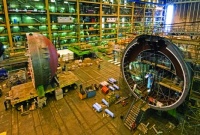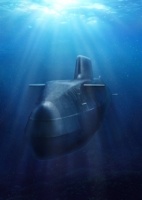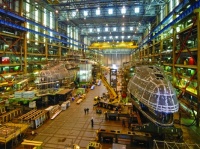A £1.2 billion nuclear-powered hunter-killer submarine is a somewhat unconventional source of civic pride. For most of us, those feelings are usually reserved for a new library, or maybe a particularly well-kept flower bed. But to the people of Barrow in Furness, who live in the shadow of BAE Systems’ massive shipyard and have ship-building in their blood, civic pride sums it up nicely. So great is the local enthusiasm for the leviathan being assembled in their midst that one is tempted to regard it as a tourist attraction in the making. It isn’t of course. For soon Astute, the first of the Royal Navy’s latest attack submarines, will leave its birthplace for a life of shadowy military operations in the murky depths of the world’s oceans.

The largest submarine of its kind ever built for the Navy, the 97m-long, 7,800 tonne vessel is expected to be lowered into the water in June next year. Following an extensive programme of sea trials, it will be handed over to the MoD in August 2008 and should enter service in 2009. It will be followed by two sister subs — Ambush and Artful. During the development of the ship, which is the first UK sub to have been entirely designed using CAD software, a team of about 800 engineers has generated more than 7,000 design drawings. The vessel, kitted out with 10km of pipework and more than 100km of cabling, will spend the whole of its 25-year working life in the sea.
Astute will be hard to detect, yet capable of communicating with the outside world. It will be able to remain hundreds of metres under water for 90 days at a time while maintaining the safety of the 98-strong crew sleeping, eating and breathing within metres of a nuclear power plant. ‘We’ve got people and high explosives close to a nuclear reactor at the bottom of the ocean and that’s a hell of an engineering challenge,’ said John Hudson, Astute’s director of engineering.
This submarine is extraordinarily quiet. It’s got a nuclear reactor and four turbines running in a plant capable of generating tens of megawatts, yet less than one watt of power is radiated into the sea — that is really quiet.
John Hudson, BAE Systems
Looking down on BAE Systems’ mammoth 25,000m2 Devonshire Dock Hall, the scale of the vessel is mind-blowing — and it’s hard not to get carried away with daydreams of adventure beneath the waves. Five minutes aboard is enough to dispel any romantic notions. The corridors are cramped, the ceilings low, and — despite the fact that this will be the first UK hunter-killer sub with a berth for each crew member — the living quarters are tiny. This environment is suitable only for those trained to endure interminable, claustrophobic months of dried food and artificial light. ‘On-board conditions are austere — it’s not built for comfort, it’s a military asset,’ said Hudson.
Its military worth is clear: it can hunt and attack other submarines and surface vessels, as well as launch cruise missile attacks on distant targets and carry out the sort of covert missions for which submarines are famed. But what really makes the vessel so valuable to the Navy is its stealth, explained Hudson. ‘This submarine is extraordinarily quiet,’ he said. ‘it’s got a nuclear reactor and four turbines running in a plant capable of generating tens of megawatts, yet less than one watt of power is radiated into the sea — that is really quiet.’

Various methods have been used to reduce the ship’s noise signature. Details of some of these, such as the proprietary acoustic tiles that cover the outer hull, are highly classified, but the key to developing a silent ship has been ensuring that each piece of machinery is as quiet as possible. For instance, rather than a propeller, the sub uses a propulsor — a Rolls-Royce developed pump-jet system consisting of moving rotor blades within a fixed duct — which is far quieter. The gearbox, developed by Yorkshire’s David Brown Engineering, is also exceptionally quiet. ‘You can stand a coin on its edge, sit it on top of the gearbox, run it at full power and the coin will stay on its edge,’ said Hudson. The signature is further reduced by damping systems that manage the transmission paths through which noise enters the water. These also help Astute withstand the high accelerations caused by a torpedo or mine exploding nearby.
Performance in these areas also owes a great deal to the way in which the vessel has been constructed. Traditionally submarines have been built from the outside-in, creating an extremely congested environment as engineers work within the confines of the pressure hull. For Astute, Hudson’s team has pioneered a modular assembly technique in which all of the main elements have been built outside the vessel as large modules, then slid into the hull once finished. As well as leading to massive improvements in the manufacturing process, the approach has created an opportunity to manage signature and shock to crew members. ‘If we had a deck welded to the pressure hull and a mine went off, the shockwave would come through the deck and chop you off at the knees,’ said Hudson. ‘By isolating the man through the module we can attenuate the shock and manage the signature so that there are limited transmission paths for any noise source on the module.’
The way the ship communicates and gathers information about its surroundings is key to its extreme stealth. As signals do not travel well under water the vessel has to get them into the atmosphere, but each time it does this it runs the risk of detection. While the Navy keeps the need for communication to a minimum by training its commanders to operate autonomously, communication is often essential and Astute uses advanced data compression techniques that enable it to send large packets of information fast. One of the most important components of this system is the periscope. BAE has taken the groundbreaking step of replacing the traditional hull-penetrating ‘up-and-down’ scope with a series of sophisticated masts that transmit data to the command deck via a cable. These are equipped with a range of equipment, thermal imaging cameras, and low-light TV and colour CCD TV sensors. They can even snort or draw in air if a reactor incident means the boat has to rely on its backup diesel generators. As well as providing a much greater capability, this system frees up some valuable space and is less visible above the water. ‘It pops up, spins round, comes down and gives you a 360 degree image that you can replay — it helps you to be more covert,’ said Hudson.

The most intriguing, and certainly the most secretive, area of submarine technology is the sonar. Hudson revealed that Astute uses a wide-aperture flank-array system developed by Thales. Capable of detecting and tracking small targets from hundreds of miles away it is, he claimed, the most advanced sonar system on any submarine in the world. It is also largely used in a passive mode to receive sound waves from external sources. ‘You don’t go round pinging off sonar like they do in the films — as soon as you do that everybody knows exactly where you are. Very, very rarely do they go active.’ The vessel’s stealthiness will make it ideal for covert operations and Hudson confirmed that this is likely to be one of its main roles. ‘Submarines traditionally have a role of being covert and this one is a lot better in that role than any previous submarine,’ he said. He declined to comment further on Astute’s covert capability, but recent reports have suggested that the submarine is designed to accommodate a dry-deck shelter — an underwater chamber that can be used by divers from the Special Boat Service. He did reveal, however, that the ship’s combat systems suite has been tested and proven on an older, Trafalgar class submarine. As a result Astute is expected to be fully capable as soon as it goes to sea. Hudson contrasted this approach with the development process of a surface warship where it is not uncommon for vessels to enter service without a full military capability. ‘To have a military platform fully functioning the day you set out for a first of class is pretty good,’ he said.
If you were a radiographer you’d receive a higher dose of radiation than a crew member on Astute.
John Hudson, BAE Systems
While the comfort of the crew has hardly been a defining factor of the design, the submarine is at least relatively safe. A range of on-board systems and engineering techniques have been used to reduce the chances of disaster. One of the most disconcerting things about life aboard a submarine of this type is the close proximity to a nuclear reactor. BAE sensibly plumped for a tried and tested Rolls-Royce pressurised water reactor. While there is little new about the technology used in this reactor, the really big challenge, said Hudson, is ensuring that the crew is protected from radiation. With the captain’s feet just metres away from the reactor, the team carried out vast amounts of neutron transport analysis during the design of the submarine to keep radiation doses as low as possible. Hudson is confident with the results: ‘If you were a radiographer you’d receive a higher dose of radiation than a crew member on Astute.’
The most important safety feature is the integrity of the boat’s huge pressure hull. Made from high-strength submarine steel, this powerful cylinder is said to withstand pressures roughly equivalent to 400 family saloon cars weighing down on every square metre of surface area. And while the submarine may be bristling with the latest military technology the traditional skill and experience of Barrow’s welders is also hugely important to the the project. Even the tiniest crack in the welds joining the sections of the pressure hull could be enough to destroy the submarine. ‘You only need one little thing to happen on a nuclear submarine and she won’t come back to the surface — a very small flood will kill a submarine,’ warned Hudson. Ensuring that the hull is strong is not as simple as making it as thick as possible.
Throughout the development of the ship the team has been extremely mindful of weight concerns. The final weight of 7,800 tonnes was, said Hudson, a non-negotiable figure. This is because beyond a certain weight a submarine will lose its buoyancy. It needs to be neutrally buoyant as it is essentially flown on its hydroplanes like an underwater aircraft. Hudson added that weight control is even more critical on submarines than on aircraft. Putting more weight on planes will, he said, just create more lift and slow you down. But putting it in a submarine will make you sink.
Another critical safety element is the vessel’s fire detection and fire fighting system which sniffs out smoke, heat, flames and carbon monoxide, while each compartment has sprinkler systems. If a fire occurs, Astute is also equipped with automatic shutdown technology to prevent smoke from spreading through the ventilation system. The most important part of this system is a network of air nozzles that crew members can clip on to if the submarine becomes filled with smoke. ‘If you have a fire, the atmosphere will become toxic very quickly, it won’t support life. With this system you can move anywhere around the ship and breath clean air,’ said Hudson. Because any fire could cause big problems for the on-board atmosphere, there is a long list of materials that cannot be used as they will give off toxic trace elements in a fire. These strict rules are carried through to the types of oils, soaps and other substances that are allowed. Crew members are not even allowed to use deodorant. While the vessel’s limitless supply of electricity means that water can be electrolysed to create oxygen, the ship is a sealed environment and the air is constantly recycled. Because of this there is a constant danger of potentially dangerous chemicals building up in the air so the ship is equipped with a system that continuously monitors the atmosphere for about 40 gases.

Looking forward to the challenges facing his team as they get stuck into Ambush and Artful, Hudson reflected on the dilemmas of picking and developing technology that the Navy will still be using in 30 years time. There is a parallel with the space industry, where shuttles are still in service decades after being built. The big difference is that the rigours a submarine is subjected to and the environment to which it is exposed are more extreme than the cold vacuum of space. ‘It’s a very tough environment. we think it’s about as tough as it gets, tougher than space,’ said Hudson. However, he is confident that Astute will rise to the challenge. ‘We think it will be a world-beating submarine. It’s a complicated and massive piece of kit, and an incredible military asset.’





Poll: Should the UK’s railways be renationalised?
I'm reminded of the old adage about stupidity is doing the same thing time and time again, expecting different results. The current model simply...